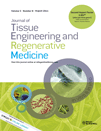Effect of capillary shear stress on recovery and osteogenic differentiation of muscle-derived precursor cell populations
Abstract
Both chemical and physical stimuli can influence the fate of precursor cell populations. Therefore, the impact they have on promoting unwanted differentiation events must be understood to improve the yield and purity of therapeutic cells for regenerative medicine approaches. Capillary shear forces, similar to those encountered during cell processing, can impact upon production of regenerative cell populations. As shear stress can promote osteogenic differentiation in adhered bone marrow-derived stromal cells, we sought to determine whether the same is true for populations of muscle-derived precursor cells (MDPCs) that were isolated from a muscle niche environment. We isolated MDPCs from craniofacial muscle of 5 day-old Royal College of Surgeons rats and subjected them to capillary shear events similar to those encountered during manual bioprocessing of cells. We then assessed whether viability and ectopic osteogenic differentiation of MDPCs was affected. We found that whilst immediate recovery of MDPCs was not significantly affected by shear, viability after 24 h was reduced in comparison to non-sheared MDPCs. By 48 h, sheared MDPCs had all recovered and had similar viability to non-sheared MDPCs. Ostegenic differentiation was enhanced following exposure to capillary shear in both osteogenic and myogenic medium. This indicates that shear forces similar to those encountered during the bioprocessing of cell populations for therapy can have a significant influence on the fate of MDPCs. Copyright © 2010 John Wiley & Sons, Ltd.




